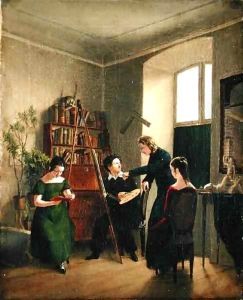Louis Asher Paintings
Louis Asher was a German painter born on May 26, 1804, in Hamburg. His full name was Johann Ludwig Asher, but he is commonly referred to as Louis Asher. He began his artistic training in his hometown before continuing his studies in Munich, which was a major center for the arts in Germany at the time. Asher later moved to Rome, which was a traditional part of an artist's education, to study the works of the old masters and to be part of the vibrant international community of artists residing there.
While in Rome, Asher became associated with a group of German artists known as the Nazarenes, a Romantic artistic movement that sought to revive honesty and spirituality in Christian art. Although not a formal member, Asher was influenced by their style and ideals. His works often included religious subjects, portraits, and historical paintings, characterized by their clear form, attention to detail, and soft, glowing colors.
Asher spent considerable time in Italy, but he also traveled back to Germany and other parts of Europe. In 1840, he was appointed as a professor at the Grand Ducal Saxon Art School in Weimar, where he influenced a generation of artists. During this time, he painted portraits of notable figures of his era, including Johann Wolfgang von Goethe, Franz Liszt, and the Grand Duchess Maria Pavlovna of Russia.
Despite his position in Weimar, Asher's artistic output was not limited to portraits. He continued to explore historical and religious themes throughout his career. His style remained consistent, with a strong emphasis on clarity and a serene, contemplative quality that reflected his Romantic sensibilities.
Louis Asher's contributions to German art were recognized in his time, and his works were collected by patrons across Europe. Today, his paintings can be found in various museums and collections, offering a glimpse into the 19th-century Romantic movement and its impact on German art. He passed away on September 7, 1878, in Munich, leaving behind a legacy that continues to be studied and appreciated by art historians and enthusiasts alike.









